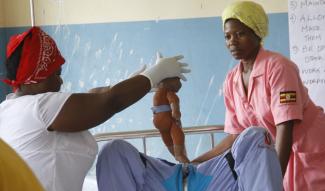Overview
The direct causes of maternal and neonatal mortality include complications that occur during pregnancy, childbirth, and the first 28 days of an infant's life. These direct causes account for approximately three-quarters of the mortality burden, including stillbirth, and are largely preventable with high quality health care. The vast majority of both maternal and neonatal deaths and stillbirths worldwide occur in low- and middle-income countries (WHO Maternal Mortality Fact Sheet, 2019). Nearly three-quarters of maternal deaths can be attributed to direct causes such as hemorrhage, infection, hypertension in pregnancy, other direct causes (e.g. delivery complications, obstructed labor) and complications of abortion. Indirect causes include pre-existing medical conditions such as heart conditions and HIV (Say, 2014).
For newborns, the three leading causes of death include infection, complications due to prematurity, and birth asphyxia. Approximately three-quarters of these deaths occur in the first week of life - two-thirds of which could be prevented with low-cost interventions, such as skin-to-skin and newborn resuscitation. In addition to these neonatal deaths, a significant proportion of the world's three million stillbirths which occur every year could be averted with improved quality of care during pregnancy and childbirth (WHO Newborn Death and Illness, 2011).
Maternal and newborn complications and outcomes are inextricably linked. Conditions that affect mothers often result in preterm or low birthweight babies. For example, preeclampsia and premature labor, if not addressed, can result in babies born preterm, underweight and vulnerable. Further, infants whose mothers die are less likely to survive (Moucheraud, 2015). Timely and optimal care for this important mother-baby dyad requires a third important component, a competent, confident health care provider with the resources needed to respond to critical emergencies. Optimizing and supporting this mother-baby-provider triad is critical to achieving the Sustainable Development goals for maternal and newborn health.













